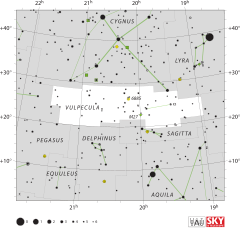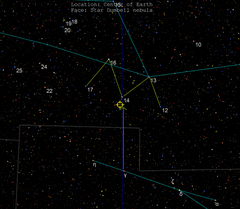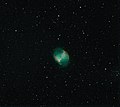Dumbbell Nebula
J2000 epoch | |
|---|---|
| Right ascension | 19h 59m 36.319s[1] |
| Declination | +22° 43′ 16.312″[1] |
| Distance | 389+15 −6[1] pc |
| Apparent magnitude (V) | 7.4[2] |
| Apparent dimensions (V) | 8.0′ × 5.6′[3] |
| Constellation | Vulpecula |
| Physical characteristics | |
| Radius | 1.44+0.21 −0.16[a] ly |
| Absolute magnitude (V) | −0.6+0.4 −0.3[d] |
| Notable features | Central star radius is among the largest known for a white dwarf. |
| Designations | NGC 6853,[1] M 27,[1] Diabolo Nebula,[1] Dumb-Bell Nebula,[1] |
The Dumbbell Nebula (also known as the Apple Core Nebula, Messier 27, and NGC 6853) is a
Shape and size
The Dumbbell Nebula appears shaped like a
Structure
Like many nearby planetary nebulae, the Dumbbell contains knots. Its central region is marked by a pattern of dark and bright cusped knots and their associated dark tails (see picture). The knots vary in appearance from symmetric objects with tails to rather irregular tail-less objects. Similarly to the Helix Nebula and the Eskimo Nebula, the heads of the knots have bright cusps which are local photoionization fronts.[5]
Central star
The central star, a white dwarf progenitor, is estimated to have a radius which is 0.055±0.02 R☉ (0.13 light seconds) which gives it a size larger than most other known white dwarfs.[6] Its mass was estimated in 1999 by Napiwotzki to be 0.56±0.01 M☉.[6]
Appearance
 Located in the faint constellation Vulpecula, within the Summer Triangle. |
 It can be located in the sky a few degrees north of γ Sagittae, near the star 14 Vulpeculae. |
The Dumbbell nebula can be easily seen in binoculars in a dark sky, just above the small constellation of Sagitta.
-
Dumbbell Nebula, north is diagonal left-up
-
Dumbbell Nebula (Messier 27) imaged by the Very Large Telescope
-
Blend of UHC and RGB exposures of M27 taken with moderate level amateur equipment in the center of a capital city
-
M27 with 5.5" telescope from city suburbs
-
Skywatcher 120mm ED APO
See also
- Messier object
- List of Messier objects
- List of planetary nebulae
- New General Catalogue
Notes
- ^ Radius = distance × sin(angular size / 2) = 1240+180
−140[7] * sin(8′.0 / 2) = 1.44+0.21
−0.16 ly - ^ Semi minor axis = distance × sin(minor axis size / 2) = 1240+180
−140[7] × sin(5′.6 / 2) = 1.01+0.15
−0.11 ly - ^ Kinematic age = semi-minor axis / expansion rate = 1.01+0.15
−0.11[b] ly / 31 km/s = 9.56+1.42
−1.04×1012 km / 31[3] km/s = 3.08+0.46
−0.34×1011 s = 9800+1500
−1100 yr - ^ 7.5 apparent magnitude - 5 × (log10(420+50
−70 pc distance) - 1) = −0.6+0.4
−0.3 absolute magnitude
References
- ^ a b c d e f g h "M 27". SIMBAD. Centre de données astronomiques de Strasbourg. Retrieved 2023-12-31.
- ^ "Messier 27". SEDS Messier Catalog. Retrieved 28 April 2022.
- ^ a b c
O'Dell, C. R.; Balick, B.; Hajian, A. R.; Henney, W. J.; et al. (2002). "Knots in Nearby Planetary Nebulae". doi:10.1086/340726.
- ^ "M 27". 2016-10-15.
- ^ a b
O'dell, C. R.; Balick, B.; Hajian, A. R.; Henney, W. J.; et al. (2003). "Knots in Planetary Nebulae". Revista Mexicana de Astronomía y Astrofísica, Serie de Conferencias. 15: 29–33. Bibcode:2003RMxAC..15...29O.
- ^ a b
Benedict, G. Fritz; McArthur, B. E.; Fredrick, L. W.; Harrison, T. E.; et al. (2003). "Astrometry with The Hubble Space Telescope: A Parallax of the Central Star of the Planetary Nebula NGC 6853". S2CID 8562211.
- ^ a b
Harris, Hugh C.; Dahn, Conard C.; Canzian, Blaise; Guetter, Harry H.; et al. (2007). "Trigonometric Parallaxes of Central Stars of Planetary Nebulae". S2CID 18261027.
External links
- SEDS: Messier Object 27
- The Dumbbell Nebula on
- M27 on astro-pics.com
- Szymanek, Nik; Merrifield, Michael. "M27 – Dumbbell Nebula". Deep Sky Videos. Brady Haran.
- M27






